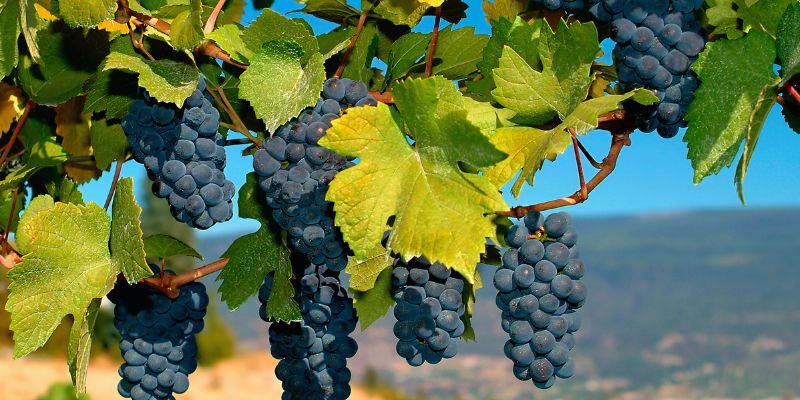Introductory Wine Course
On Bordeaux Grapes
Bordeaux's reputation rests on the complementary relationship between Cabernet Sauvignon and Merlot, two varieties that rarely appear alone in this region but instead blend to create wines greater than their individual parts. Understanding these grapes means recognizing how soil, climate, and blending philosophy differ between the Left and Right Banks of the Gironde estuary, producing distinct regional styles from the same basic varieties. The 1855 Classification and Saint-Émilion's separate system add layers of complexity to Bordeaux's hierarchy, reflecting historical quality assessments that continue influencing prices and prestige. Mastering these distinctions enables precise guidance when navigating Bordeaux's intricate landscape of appellations, châteaux, and classifications.
Cabernet Sauvignon and Merlot: Flavor Profiles and Complementary Roles
Cabernet Sauvignon produces deeply colored wines with substantial tannins derived from its thick skins, showing flavors of blackcurrant, black cherry, and blackberry alongside cedar, tobacco, graphite, and bell pepper notes. The variety ripens late, requiring warm conditions to achieve full maturity, and naturally produces structured wines with firm acidity and significant aging potential. Its tannins can seem aggressive in youth but soften beautifully over decades, developing tertiary characteristics of leather, earth, and cigar box. Merlot ripens earlier and contains less tannin, offering softer structure and rounder mouthfeel with flavors of plum, black cherry, chocolate, and herbal notes. The variety provides immediate accessibility and fleshes out blends with generous fruit and supple texture. When combined, Cabernet Sauvignon contributes backbone, ageability, and aromatic complexity, while Merlot adds mid-palate richness and approachability. Weather patterns impact each variety differently. Cool, wet conditions during Merlot's earlier flowering and ripening can reduce yields and encourage rot, while Cabernet Sauvignon's later harvest faces autumn rain risks. Vintage quality in Bordeaux often depends on September and October weather, with warm, dry conditions allowing Cabernet full ripeness. Great vintages provide sufficient warmth for both varieties, while challenging years may favor one over the other.
The region of Bordeaux is inextricably linked to the success of wine across the world, having been the source of fine wine for the aristocracy of Europe for centuries.
Left Bank Versus Right Bank: Terroir and Style Distinctions
The Left Bank, encompassing the Médoc and Graves regions, features gravelly soils that drain excellently and retain daytime heat, creating ideal conditions for late-ripening Cabernet Sauvignon. Appellations like Pauillac, Margaux, Saint-Julien, and Pessac-Léognan produce Cabernet-dominant blends, typically 60 to 80 percent Cabernet Sauvignon with Merlot and smaller amounts of Cabernet Franc, Petit Verdot, and occasionally Malbec. These wines show structured tannins, pronounced cassis and cedar characteristics, firm acidity, and require years or decades to soften and integrate. The 1855 Classification, created for the Exposition Universelle de Paris, ranked Left Bank estates into five growth levels from First through Fifth, plus Crus Bourgeois below. This hierarchy, which included only one Graves property and focused primarily on Médoc châteaux, remains influential despite being based on 19th-century pricing rather than current quality. The Right Bank, including Pomerol and Saint-Émilion, contains more clay and limestone soils that suit earlier-ripening Merlot, which typically comprises 60 to 90 percent of blends alongside Cabernet Franc. Right Bank wines offer softer tannins, more immediate approachability, and flavors emphasizing plum, chocolate, and truffle rather than cassis and cedar. Saint-Émilion maintains its own classification system, reviewed approximately every decade, ranking properties as Premier Grand Cru Classé A and B, and Grand Cru Classé. Pomerol has no official classification despite producing some of Bordeaux's most expensive wines.

Communicating Distinctions on Style and Price Point
Understanding Left versus Right Bank differences proves essential when guiding guests and friends through Bordeaux selections based on preferences, budgets, and drinking timelines. Left Bank wines suit those seeking structured, age-worthy bottles that pair with rich meats and benefit from extended cellaring. These wines often taste austere or tannic in youth, requiring explanation about development potential and ideal drinking windows. The 1855 Classification provides a quality framework, though customers should understand that classifications reflect historical reputation rather than guaranteeing current performance, and that excellent wines exist outside classified growth ranks. Right Bank wines appeal to those preferring softer, more immediately enjoyable bottles or who want Bordeaux character without extensive aging. The higher Merlot content creates approachability that works well for customers new to Bordeaux or seeking wines for near-term consumption. When discussing specific châteaux, mentioning their bank and dominant variety immediately communicates style expectations. Price differences between banks reflect both classification prestige and production costs, with Left Bank's famous names commanding premiums while Right Bank offers compelling values alongside its trophy bottlings from Pétrus, Le Pin, and top Saint-Émilion estates.
Distinguishing between Left and Right Bank Bordeaux enables accurate guidance based on grape composition, structural differences, and stylistic expectations. Recognizing how Cabernet Sauvignon and Merlot contribute distinct characteristics, how terroir shapes their expression, and how classification systems establish quality hierarchies allows meaningful communication about these complex wines. This knowledge proves critical when selling Bordeaux, ensuring recommendations align with customer preferences for structure, aging potential, and flavor profiles while building trust through nuanced understanding of one of wine's most important and intricate regions.